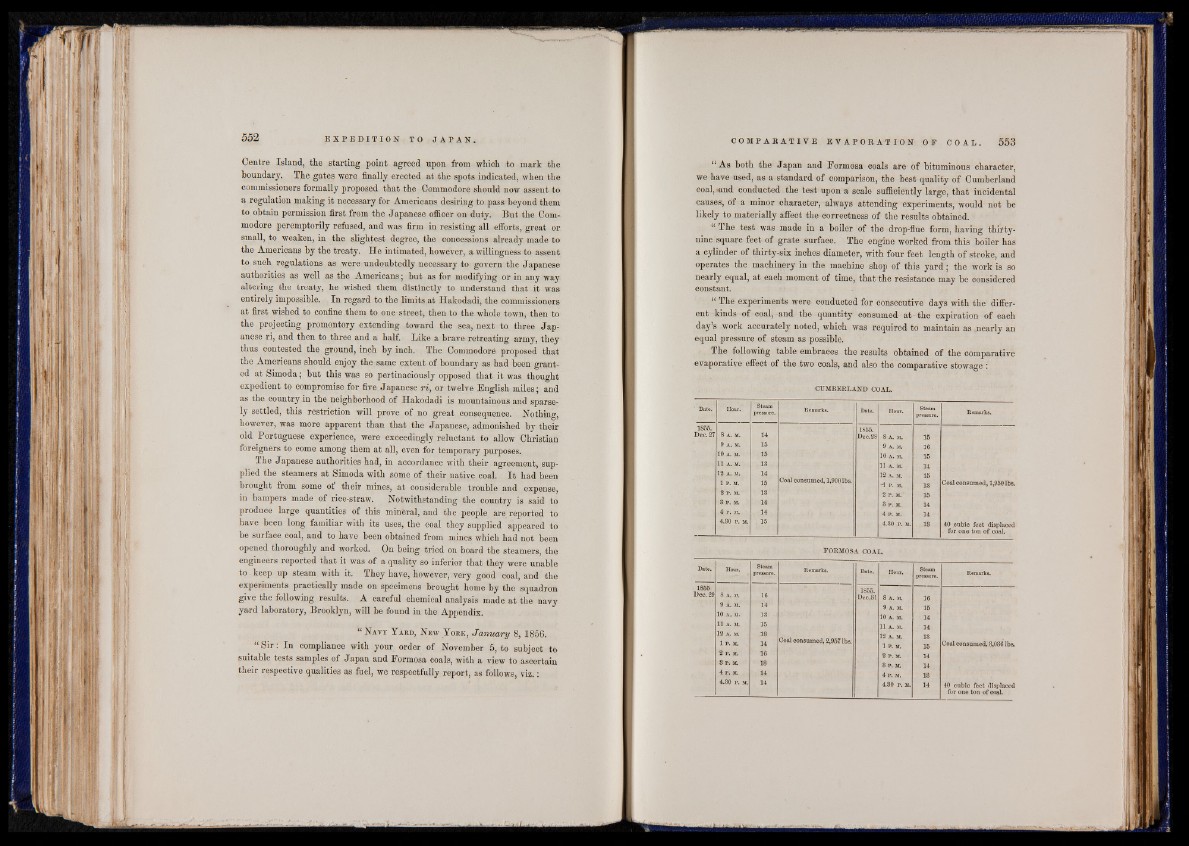
Centre Island, tie starting point agreed upon from which to mark the
boundary. The gates were finally erected at the spots indicated, when the
commissioners formally proposed that the Commodore should now assent to
a regulation making it necessary for Americans desiring to pass beyond them
to obtain permission first from the Japanese officer on duty. But the Commodore
peremptorily refused, and was firm in resisting all efforts, great or
small, to weaken, in the slightest degree, the concessions already made to
the Americans by the treaty. He intimated, however, a willingness to assent
to such regulations as were undoubtedly necessary to govern the Japanese
authorities as well as the Americans; but as for modifying or in any way
altering the treaty, he wished them distinctly to understand that it was
entirely impossible. In regard to the limits at Hakodadi, the commissioners
at first wished to confine .them to one street, then to the whole town, then to
the projecting promontory extending toward the sea, next to three Japanese
ri, and then to three and a half. Like a brave retreating army, they
thus contested the ground, inch by inch. The Commodore proposed that
the Americans should enjoy the same extent of boundary as had been granted
at Simoda; but this was so pertinaciously opposed that it was thought
expedient to compromise for five Japanese ri, or twelve English miles; and
as the country in the neighborhood of Hakodadi is mountainous and sparsely
settled, this restriction will prove of no great consequence. Nothing,
however, was more apparent than that the Japanese, admonished by their
old Portuguese experience, were exceedingly reluctant to allow Christian
foreigners to come among them at all, even for temporary purposes.
The Japanese authorities had, in accordance with their agreement, supplied
the steamers at Simoda with some of their native coal. I t had been
brought from some of their mines, at considerable trouble and expense,
in hampers made of rice-straw. Notwithstanding the country is said to
produce large quantities of this minferal, and the people are reported to
have been long familiar with its uses, the coal they supplied appeared to
be surface coal, and to have been obtained from mines which had not been
opened thoroughly and worked. On being tried on board the steamers, the
engineers reported that it was of a quality so inferior that they were unable
to keep up steam with it. They have, however, very good coal, and the
experiments practically made on specimens brought home by the squadron
give the following results. A careful chemical analysis made at the navy
yard laboratory, Brooklyn, will be found in the Appendix.
“ Navy Yard, New York, January 8, 1856.
I S ir: In compliance with your order of November 5, to subject to
suitable tests samples of Japan and Formosa coals, with a view to ascertain
their respective qualities as fuel, we respectfully report, as follows, viz.:
“ As both the Japan and Formosa coals are of bituminous character,
we have used, as a standard of comparison, the best quality of Cumberland
coal, «and conducted the test upon a scale sufficiently large, that incidental
causes, of a minor character, always attending experiments, would not be
likely to materially affect the correctness of the results obtained.
“ The test was made in a boiler of the drop-flue form, having thirty-
nine square feet of grate surface. The engine worked from this boiler has
a cylinder of thirty-six inches diameter, with four feet length of stroke, and
operates the machinery in the machine shop of this yard; the work is so
nearly equal, at each moment of time, that the resistance may be considered
constant.
• “ The experiments were conducted for consecutive days with the different
kinds of coal, and the quantity consumed at ■ the expiration of each
day’s work accurately noted, which was required to maintain as nearly an
equal pressure of steam as possible.
The following table embraces the results obtained of the comparative
evaporative effect of the two coals, and also the comparative stowage :
CUMBERLAND COAL
D ate. H o n r.'
p ressure . R em a rk s . Date. H o u r. Steam
p ressure . R em a rk s .
1855.
Dec. 27 8 A. SI. 14 Dec.28 8 A. M. 15
9 a . m . 15 9 A. 31. 16
10 A. M. 15 10 A. 31. 15
11 A. M. 18 11 A. 31. 14
12 A. M. 14 12 A. M.
1 P . 31. 15 Coal consumed, 1,900 lbs.
- i P . 31. 18 Coal consumed, 1,950 lbs.
2 P . M. 18 2 P . 31. 15
8 P . M. 14 8 P . 31. 14
4 P . 31. 14 4 P. 31. 14
4.80 p. 3i. 15 4.80 p. 3i. 18 40 cubic feet displaced
for one ton of coal.
FORMOSA COAL.
Date. Hour. ^ Steam Remarks. Date. Hour. pressure. Remarks.
1855
Dec. 29 8 A. 3f.
9 A. 31.
10 A . 31.
16
14
18 -
1S55.
Dec.31 8 A. 31.
9 A. M.
10 A. 31.
16
15
14
11 A. 31.
12 A. 31.
1 P . 31.
15
18
14 Coal consumed, 2,957 lbs.
11 A. 31.
12 A. 31.
1 P . M.
14
18
15 Coal consumed, 3,086 lbs.
2 P. 31. 16 2 P . M. 14
8 P . 31. 18 8 P . 31. 14
4 P. 31. 14 4 P . M. 18
4.80 p. k 14 4.80 p. 3i. 14 40 cubic feet displaced
for one ton of coal.